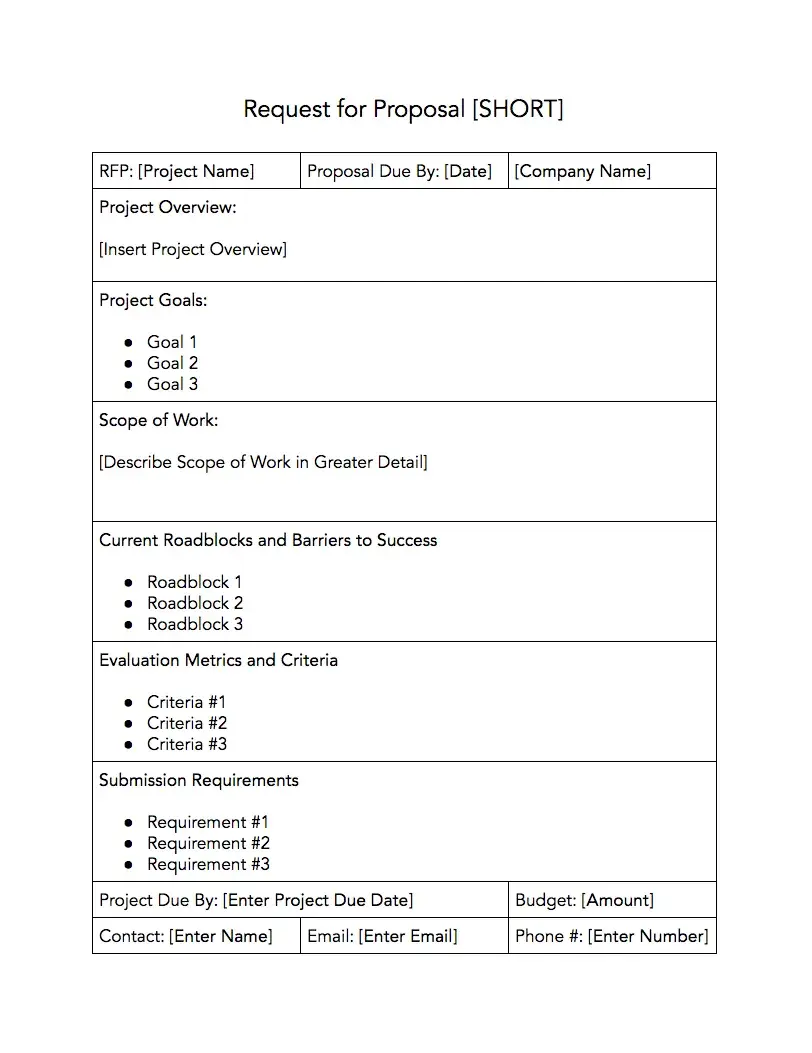
The Ultimate Guide to RFPs — All The Tips I Learned From Experts
This is the guide for you if you’re creating a request for a proposal (RFP) for the first time or if you want to improve your RFP process.
In this article, I’m diving into the specifics of what an RFP is, why you might need one, when to issue an RFP, and how to create your very first RFP today.
I’ve reached out to senior sales professionals, marketing leaders, and CEOs who are already using the RFP process. Want to learn from the best? Take note of their top tips for getting the most out of RFPs.
What exactly is an RFP?
Let’s first dig into the definition of an RFP.
And you’ll have this information before you ever have to commit to the vendor.
RFP vs. RFQ
An RFQ is a Request for Quotation, which differs slightly from an RFP.
Maurice Harary is CEO and co-founder of The Bid Lab, a company that responds to RFP and grant responses for businesses and non-profit organizations. Harary recommends that companies are better off sending an RFQ before the RFP.
Harary says, “Never skip out on issuing an RFQ before you issue an RFP. Learn what makes a vendor qualified for the job before you issue that industry cattle call.”
Once you’ve issued, reviewed, and assessed responses from an RFQ, Harary says that teams should have a realistic idea of the requirements necessary to implement the desired solution. You can then tweak your RFP according to industry feedback before you post the official version of your request.
“When you do finally publish your RFP, you will have learned exactly which elements of the solution you need to stress to potential respondents up front —and, conversely, you‘ll know to be clear about what won’t work for your organization,” Harary notes.
From there, the resulting responses will be more relevant and tailored according to the guidelines you established in the RFP and RFQ. And, Harary says, “Since you issued that RFQ, you’ll probably also have a better rate of responses to boot.”
What is an RFP in marketing?
In Marketing, an RFP is often used to outsource marketing activities.
If you work at a small startup, you might create an RFP to find a full-service communications and marketing firm to create an integrated marketing plan for your business. A successful marketing RFP would outline that you’re looking for a firm to help you “increase SEO presence” or “attract social media followers,” etc.
What is an RFP in sales?
In sales, an RFP is often created when a business is looking to purchase a product or service to suit its needs. For instance, if an enterprise company is looking for new CRM software, the business might release an RFP that outlines what it’s looking for and what it hopes to achieve with the new CRM software.
RFPs can play a critical role in the enterprise sales cycle. Enterprise companies that issue RFPs often look for businesses that can provide them with IT support, security, onboarding and training, and other services.
Why issue a request for proposal?
Let’s briefly compare these two scenarios:
- Option #1: Spend time finding the perfect vendor on your own.
- Option #2: Use an RFP to get potential vendors to come to you.
Or, you might search Google to check out the top vendors in your area.
Imagine how long that’s going to take!
And to save you even more time, it would be up to potential contractors — not you — to reach out.
RFP Benefits
- Saving you time. As explained in the scenarios above, an RFP saves you tons of time when doing vendor outreach. Instead, you can create one RFP document, publish it, and have the vendors come to you.
- Expanding your network. When doing the outreach yourself, you’re most likely to stay within your own network, relying on referrals. While referrals are great, publishing an RFP online allows you to reach a much larger swath of vendors.
- Offering vetted solutions. The RFP route also gives you a sneak peek into each vendor’s real plan of action, not the one they talk you into over the phone or in person. Since potential candidates have to submit a formal bid, they’ll need to spend time outlining the solution and really working through the problem at hand.
But, to get to this point, you have to avoid one major pitfall: timing.
When to Issue an RFP
You will issue an RFP when your company needs a product or service from an external vendor.
For respondent time, according to Loopio, the majority of respondents will reply within ten days, but 29% of respondents will take eleven days or more. If you want to catch the majority of respondents, you might want to wait for two weeks before making your shortlist.
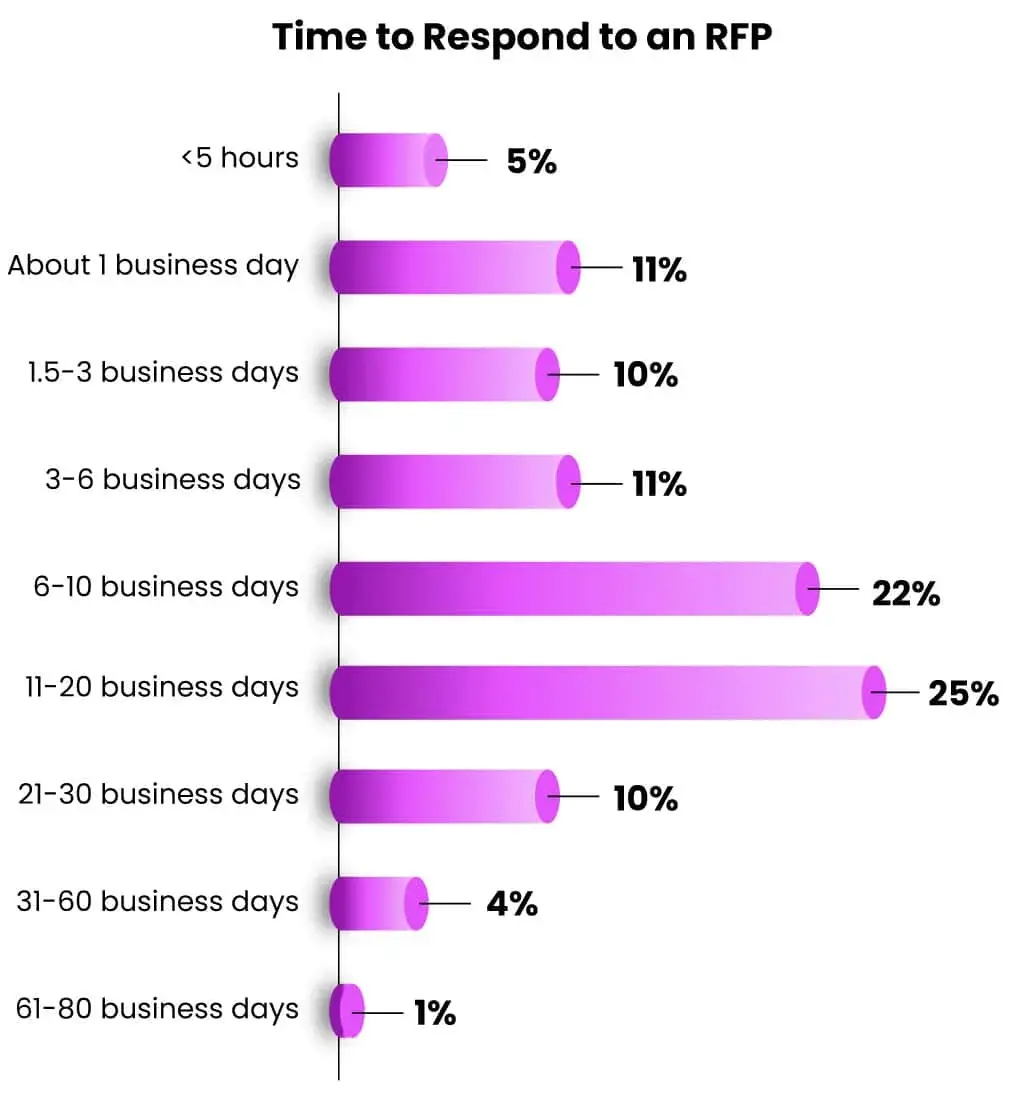
RFP Use Cases
Technology Procurement
Marketing and Advertising Services
Event Management
Truly, you can use the RFP process for anything! Now, I’ll explain how the process works.
The RFP Process Explained
In your RFP, you can ask for anything you like, but generally, you’d at least ask for
- An action plan to solve your issue
- A timeline of what you can expect
- Any necessary background information
- How much entire project will cost
Next, I’ll break down the process of creating the perfect RFP.
5 RFP Stages to Get the Best Bids
1. Assess what you need.
Top tip: Be very detailed about what you want. Remember the differences between the RFQ and RFP. The RFP is more thorough and asks a lot from vendors. According to Loopio, it takes the majority of respondents 30 hours to complete an RFP. Let this give you a gauge of how much you can ask for.
2. List any technical specifications.
Including technical specifications up front in your RFP allows vendors to determine whether or not they can provide what you need.
This also protects your business because if a vendor agrees that they can meet your specifications initially but fails to deliver once they’ve taken on the project, you can hold them accountable to the specifications listed in the RFP.
3. Distribute the RFP.
Once the RFP is written, it’s time to send it out. There are many ways to distribute an RFP.
You can:
- Publish it on your website and create a specific landing page.
- Leverage any industry-related professional groups you’re a member of and advertise it there.
- Utilize your local chamber of commerce, which is also an excellent place to advertise your RFP if you’d prefer to work with a local vendor.
- Use online RFP portals.
Early in the RFP process, bidders may request adjustments based on their industry experience. At this point, you can either review their feedback and create a new RFP to accommodate the changes, or you can leave the original as is and consider it while considering the other submitted bids.
It’s worth noting that aforementioned expert Maurice Harary warns, “If you‘re receiving a deluge of questions from vendors, or you’re seeing huge differences in cost estimates from vendor to vendor, then your RFP wasn’t well-understood.”
4. Evaluate your offers.
Once you receive all the proposals, it will be almost effortless to compare each and determine which vendor best fits your company.
Out of the stack of bidders, you’ll want to narrow this down to a handful of your top three, five, or 10 favorites to consider, depending on how many you receive or are interested in. From here, you’ll want to spend time vetting potential vendors further to determine who’s really the ideal fit for the job.
Top Tip: Don’t rush to choose a vendor. Respondents will reply in their own time, with some taking more time than others. Though the early respondents may not be the best, it’s fair to say an early reply may be an indicator of efficiency, which might be important to you.
5. Select the best vendor for the job.
Some companies may request one more best and final offer from their top vendors after they’ve started this negotiation process to ensure they’re getting the right person or company for the job and at the right price.
While this may sound like an extra step, it could save you money, time, and headaches down the road.
But this also leads us to a big question: Is all of this really necessary?
How to Write an RFP
Here’s the basic structure of an RFP and what to include in yours:
1. Project Overview
Max DesMarais, Director of Strategy at Vital Design, receives dozens of RFPs each month. He recommends “an overview section with bulleted or key-listed information about timelines, budgets, response format, and scope.”
2. Company Background
This shouldn’t be a long history of your company. Rather, it should give contractors context.
You want to focus on the most relevant details. For example, the sector your company operates in, the company’s core values, the types of clients or customers you serve.
3. Project Goals
Ideally, you will be able to clearly identify what you want to accomplish with this project and what a successful project looks like for you.
This information will help vendors understand your needs exactly and help them determine if they’re a good fit to work with you. Clearly identifying your needs will also help vendors with costs.
Sometimes, those writing the RFP don’t know the solution in its entirety. Perhaps it’s a technical solution. You should exhaust your company’s internal knowledge first; speak to your peers and see what you can pull together.
In circumstances where there are gaps, Alex Wilson, marketing director at pixelframe Design, has a great tip.
“If you don’t know the specific solution required, describe the problem that needs solving,” Wilson says.
According to Wilson, a frequent challenge in responding to RFPs is having to determine what the client really needs versus what they’re asking for.
“If you skip the research phase of crafting your RFP, you may be asking for services that don‘t properly solve your issue, and if you haven’t properly outlined the problem, the agency won’t be able to help guide you,” says Wilson.
This is excellent advice from Wilson because it allows you to be descriptive of what you want without the need to lay it out exactly.
4. Project Scope
The details of the project are essential in an RFP. Spend time detailing your project scope so there are no surprises later on. Remember, you’re looking to provide an RFP that will take ten hours to complete. It needs to be detailed.
The project scope wants to be as detailed as it needs to be but concise.
Dan Christensen, owner, CEO, and founder at DJC Law, has some great advice when it comes to streamlining the RFP process without sacrificing detail.
He says, “Be as clear and detailed as possible in the requirements while also keeping it focused. Outline exactly what you need, why you need it, and the criteria that will be used to evaluate responses.”
According to Christensen, RFPs are often vague, leaving respondents to make assumptions and requiring lengthy and unfocused responses.
“A tightly defined and well-structured RFP allows respondents to provide the right information efficiently. I recommend dividing requirements into must-haves versus nice-to-haves, being very specific on timelines, deliverables, performance metrics, and providing respondents with any templates or formats you want responses in,” Christensen says.
5. Target Deliverable Schedule
Even if your deadlines aren’t super tight, you should still have a target deliverable schedule in mind. This needs to be included in your RFP so potential vendors can properly gauge if they have the resources and bandwidth to complete the job on time.
When you set your deliverable schedule, you must consider the RFP process.
Jakub Kozlowski, Sales Manager at People for Pools, says, “Establishing a clear timeline, allowing for questions and clarifications, and providing structured evaluation criteria can streamline the process and ensure a more efficient review of the proposals.”
I like how Kozlowski has specified “allowing for questions and clarifications.” In my experience, there is always a problem to solve, and Kozlowski reminds us to consider the things that we might not expect or account for.
6. Possible Roadblocks
Don’t hide your existing or potential issues under the proverbial rug if you want them to disappear.
A successful RFP is explicitly clear about any technical issues or possible roadblocks, such as: Are you dealing with custom coding or an outdated platform? Does your team have limited resources?
By explaining this upfront, potential vendors will know exactly what they’re getting into.
You’ll also naturally weed out contractors who can’t handle the task due to those constraints.
But you’ll also connect with companies that know how to work around these common issues with skill and finesse.
Remember, it’s far better to find this out now than after you’ve accepted the bid and started work.
7. Budget Constraints
It’s important to be upfront with your budget. This looks better for potential vendors because they know they’re not wasting time responding.
Alex Wilson of pixelframe Design warns that not including a budget could result in your RFP being skipped altogether. Wilson says, “Include a budget. A range is fine, but not including a price at all makes your RFP much more likely to be skipped.”
It’s not just about setting the budget but being upfront with the scope in the steps above so the respondents can see what’s involved and how to price. A thorough RFP will help with budgeting and prevent surprises later.
Reyansh Mestry, Head of Marketing at TopSource Worldwide, says, “By prioritizing deliverables and outcomes in our project proposals, we’ve ensured that vendors concentrate on what really matters — achieving our desired results. This focus has helped us avoid unnecessary complexity and kept the project aligned with our strategic goals.
Vendors who understand the importance of outcomes are more likely to propose solutions that are tailored to our specific needs, leading to greater efficiency and effectiveness in project execution. The clarity provided by this approach has also reduced misunderstandings and scope creep, allowing us to stay within budget and timeline constraints.”
The more information upfront, the more likely your vendor can provide you with a price that a) meets your budget and b) meets the price with the full scope.
8. What You’re Looking For in Potential Vendors
Another way to reduce or eliminate surprises is to explain exactly what you’re looking for in potential contractors.
All you have to do is outline what matters most to your project (i.e., time, solution, budget, etc.) and show how you’ll evaluate their proposals.
Brett Ungashick, CEO and CHRO of OutSail, has some advice on crafting your questions to vendors in a way that allows them space to demonstrate their USPs.
Ungashick uses RFP for software selection as an example. He says, “We avoid generic feature-based queries because most platforms have similar capabilities, which can result in nearly identical responses.”
“Instead, we ask about areas where there can be meaningful variation, such as cost structures, service models, innovation cycles, and product architecture. This approach not only streamlines the evaluation process by cutting down on redundant information but also draws out richer, more revealing responses that showcase each vendor’s unique strengths and approaches.”
Sample Responses to RFPs
Example One: General RFP Response for Web Design Services
Free and Editable RFP Template
Download a free, editable RFP template.
To use this template, simply download it here or fill out the form below.
You can remove sections or pieces of information that don’t pertain to your project and add whatever else you need for your RFPs.
You can also use this tried-and-tested proposal formula to ensure your RFP is professional and polished, too.
Proposal Software Tools to Help You Manage RFPs
Below are five tools to improve your RFP response.
1. Responsive
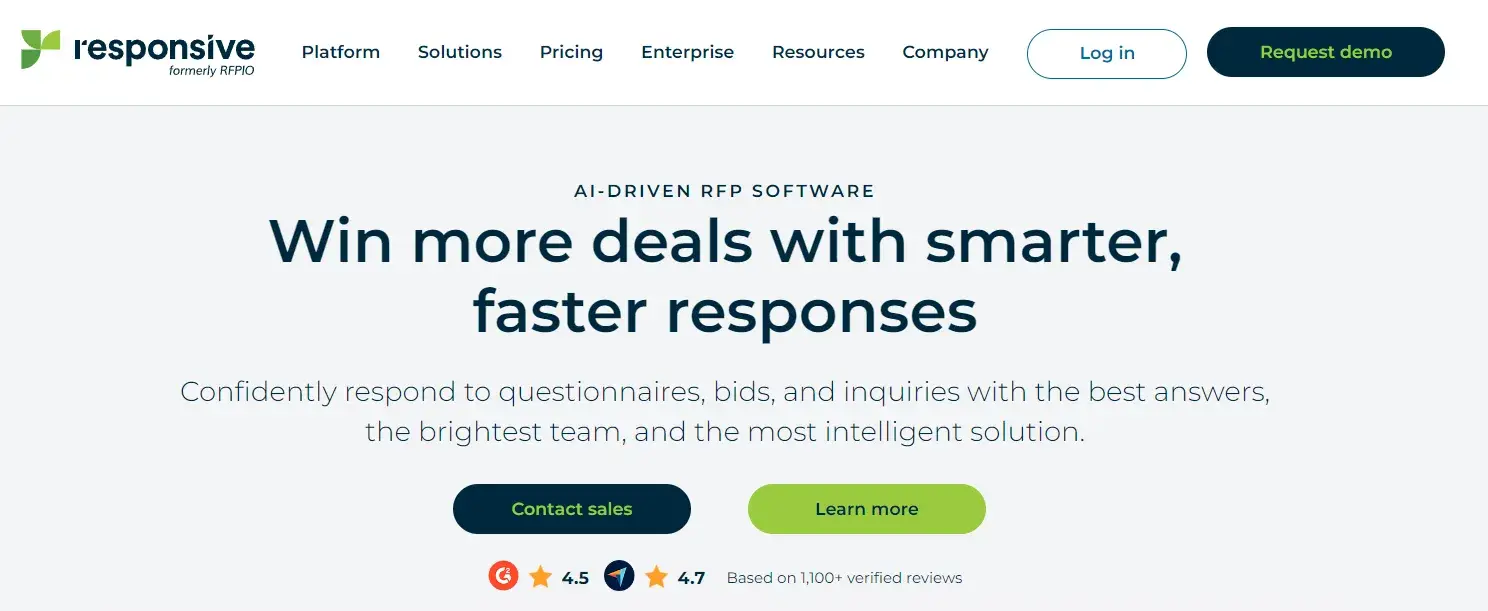
Responsive solves the problem of responding to RFPs, from project management to collaboration to integrating with other software.
Their solution includes reporting dashboards, auto-response features, and automated generation of proactive proposals from within your CRM.
Responsive also includes an intelligent answer library that turns previous RFP responses into on-demand intelligence that empowers revenue teams with enterprise content at their fingertips wherever they work.
And what’s better? Responsive has an integration with HubSpot that will automatically sync your RFP with your portal, making it easy to share information with your team.
2. PandaDoc

To create customized RFPs with your own branding, consider using the proposal software PandaDoc.
Here, you can set up your first RFP within minutes and even collaborate with team members using real-time updates in the document itself.
3. Nusii
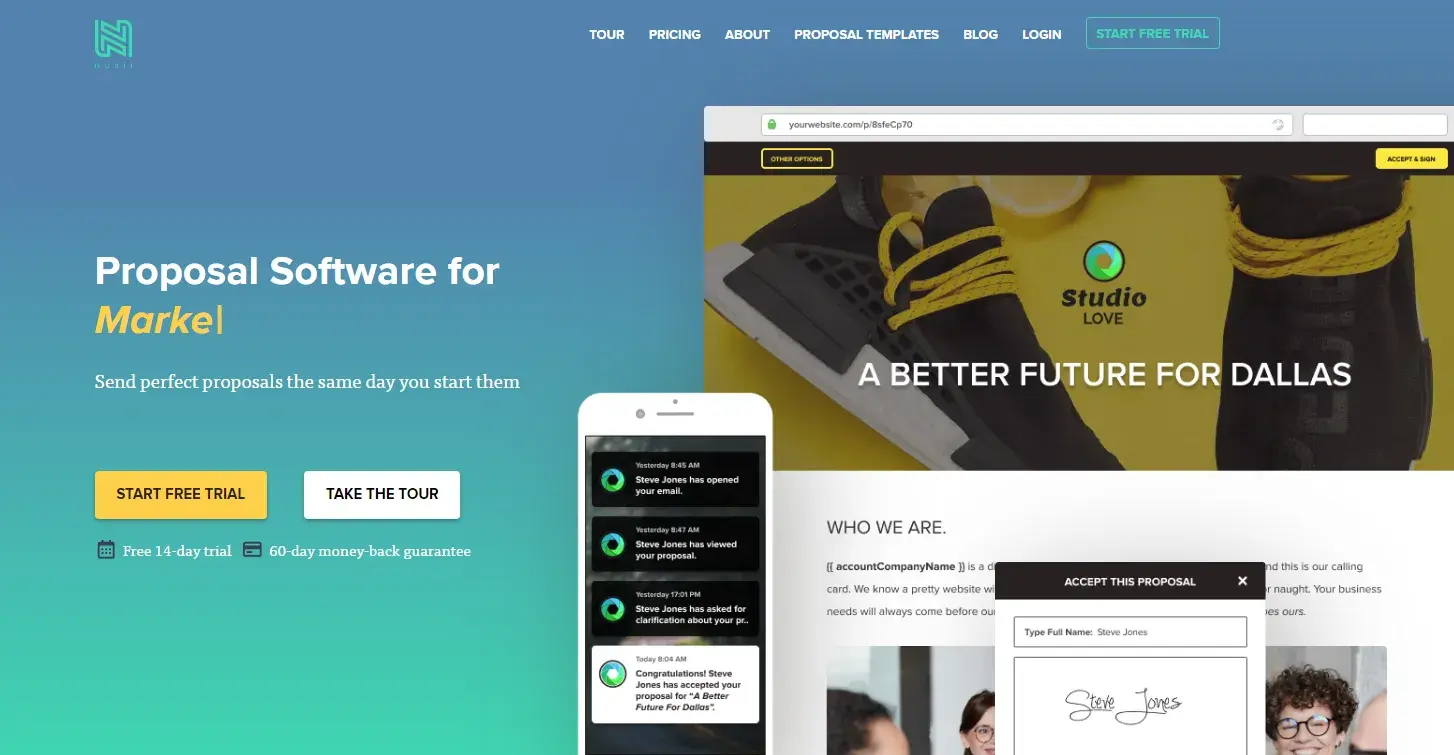
Similar to other proposal software on the market, Nusii uses a drag-and-drop editor that makes building RFPs a breeze — especially for beginners.
Thanks to its clean, modern, simple design, it’s also really easy to figure out.
One of Nusii’s most helpful features is its ability to rework existing RFPs, which can save you time. You can copy the content from an RFP you like and edit the information to fit your new request.
4. Loopio
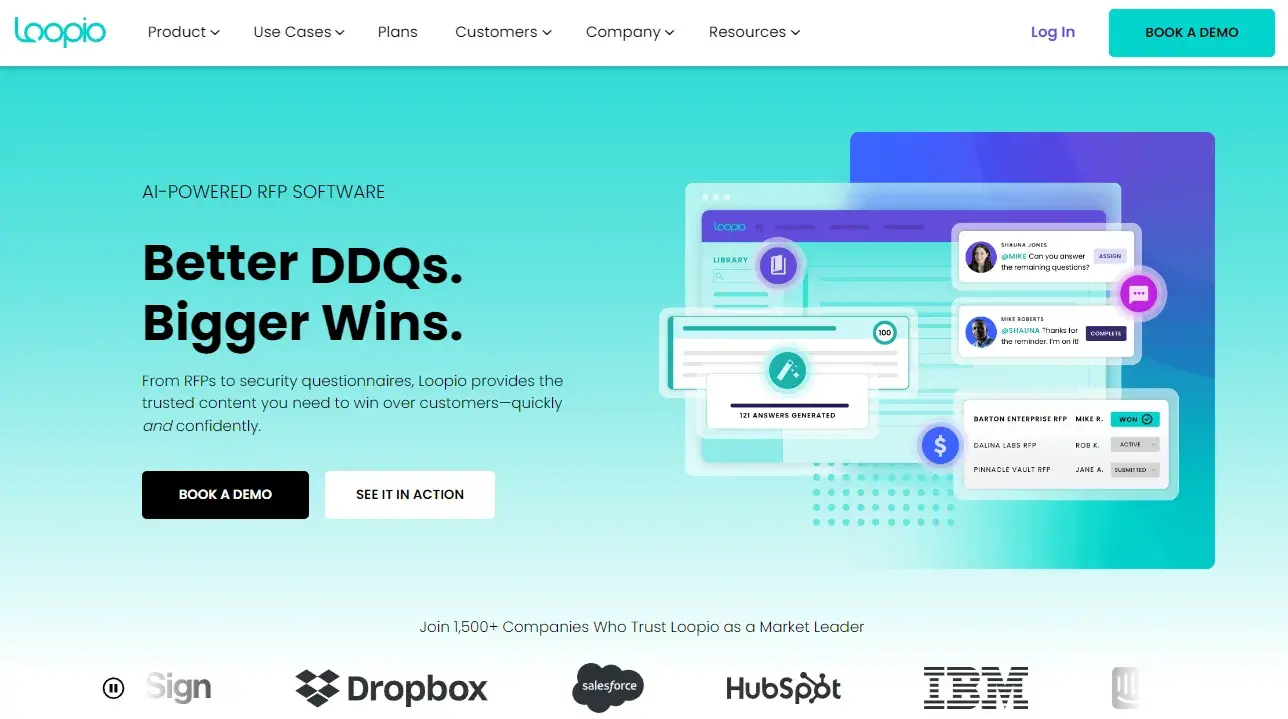
How do you plan on organizing all the responses to your RFPs?
One standout feature withLoopiois its RFP response library, which gives you instant access to all your answers from previous RFPs. This saves you the hassle of digging around to find what you need in a crowded inbox.
Their magic feature will even help you auto-populate a response if it appears similar to one you’ve already done.
Plus, you can manage your entire RFP process — including sending automated responses — and collaborate with your team all in one place with their intuitive dashboard.
And if proposal tools are out of the budget right now, or if you’d like to try your hand at creating your own first, use one of these templates as a starting point.
5. Proposify
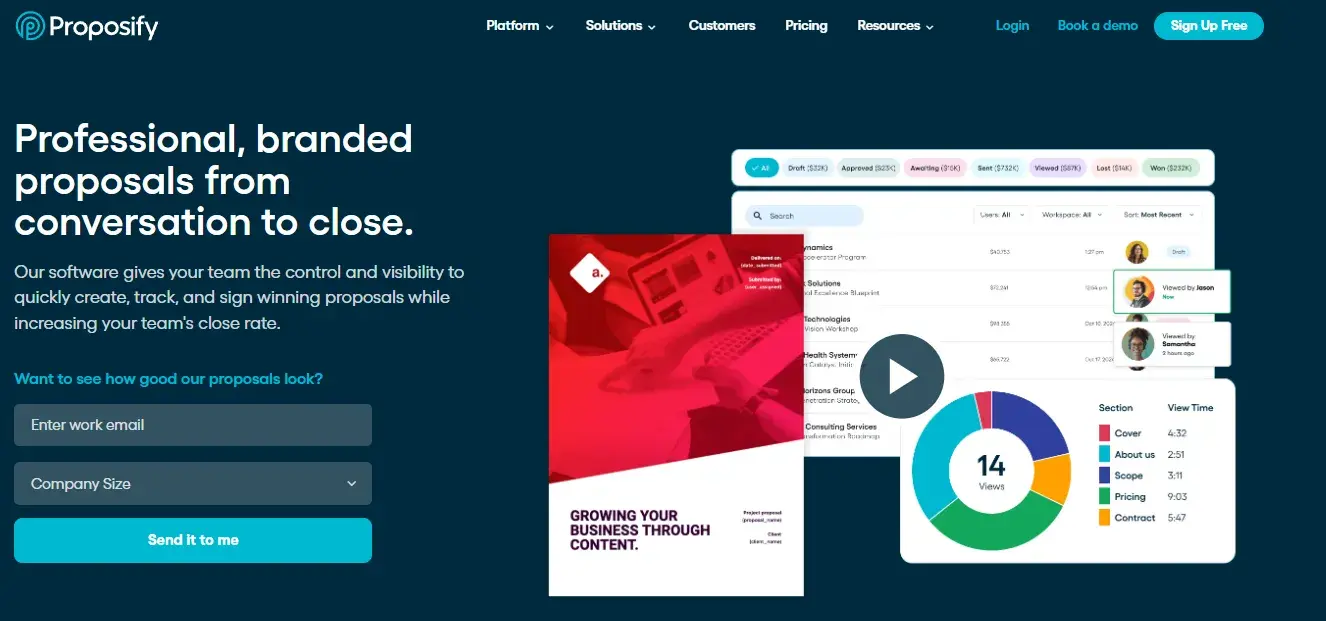
Proposify makes creating proposals effortless. You can create proposal templates to reuse content and pages for future proposals; a great feature for pages and content that won’t change is your company overview, for example.
Proposify will alert you when your proposal has been viewed and allow recipients to sign digitally. It also offers analytics so you can see which pages are viewed and for how long. This data can be used to optimize your proposal template for maximum engagement.
Create an RFP With Ease
With this intel, you’ll be ready to plug everything into our template.

